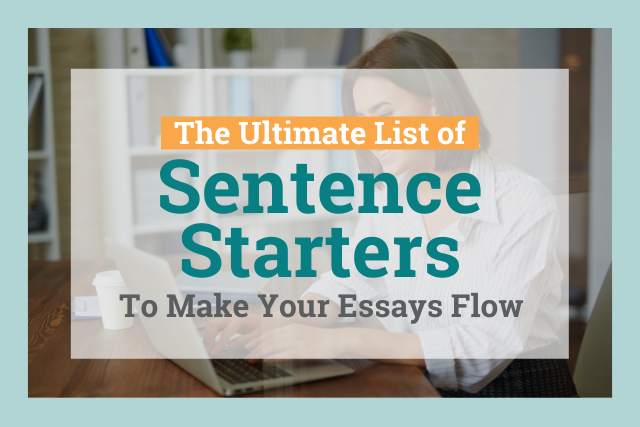
This blog post is going to be about … No. Too boring.
Today, I am going to talk to you about ... No. Too specific.
This is a blog post for all writers ... Nope. Too generic.
Has this ever been you while writing? I get it. Writing a good sentence can be hard, and when you have to string a whole lot of them together, the task can become daunting. So what do you do?
From the first sentence you write to the very last, you want each one to show your style and motivate your reader to keep reading. In this post, we are going to think about how you start your sentences.
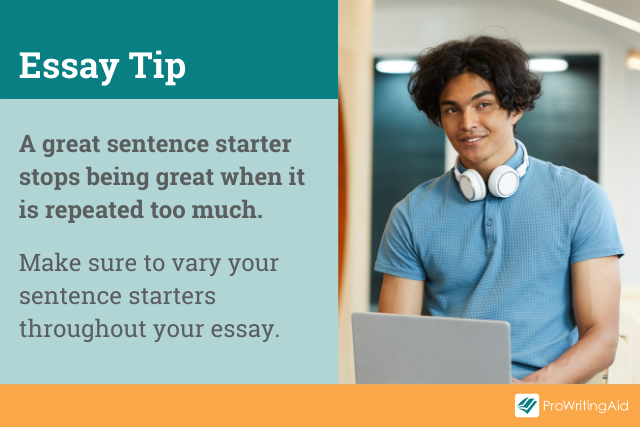
What Is a Good Sentence Starter for an Essay Introduction?
The first paragraph of a paper can make or break your grade. It is what gets your audience into the topic and sets the whole stage. Because of this, it is important to get your readers hooked early.
The first sentence of a paper is often called the hook. It shouldn’t be anything ordinary. It should have strong language and be a little surprising, with an interesting fact, story, statistic, or quote on the topic.
Because it is designed to pull the reader in and surprise them a little, it is often good to avoid pre-written sentence starter examples when writing your hook. Just get into it here, and worry about the flow later.
Here are some examples:
Spider webs were once used as bandages.
I taught myself to read when I was three. At least, that’s the story my parents tell.
Recent studies suggest that the average person lies at least once in every conversation.
“The world is bleeding and humans wield the knife,” or so says environmental scientist So Andso.
(P.S. Except for example 1, which is true, I just made all of these up to demonstrate my point. So, please don’t quote me on these!)
Once you jump right in with your hook, it is time to start working on ways to move sentences along. Here is where you may need some sentence starter examples.
In your first paragraph, you basically want to connect your hook to your thesis. You’ll do this with a few sentences setting up the stage for your topic and the claim you will make about it. To do that, follow the tips found in the next section on body paragraphs and general sentence starter tips.
What Is a Good Sentence Starter for a Body Paragraph?
Many of the tips I am about to discuss can be used anywhere in a paper, but they are especially helpful when writing body paragraphs.
Let’s start with one of the most important types of sentence starter in essay writing: transition words.
How Do I Use Transitions in an Essay?
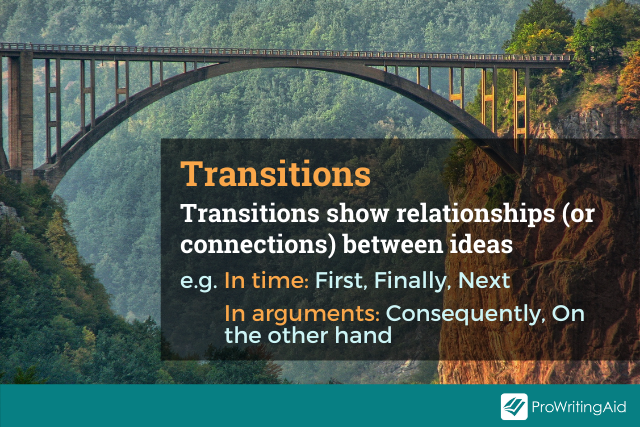
If you want to start writing terrific sentences (and improve your essay structure), the first thing you should do is start using transition words.
Transition words are those words or phrases that help connect thoughts and ideas. They move one sentence or paragraph into another, and they make things feel less abrupt.
The good thing about transition words is that you probably know a lot of them already and currently use them in your speech. Now, you just need to transition them into your writing. (See what I did there?)
Before we get into examples of what a good transition word is, let’s look at a paragraph without any transitions:
I went to the store. I bought bacon and eggs. I saw someone I knew. I said hello. I went to the cashier. They checked me out. I paid. I got my groceries. I went to my car. I returned home.
Yikes! That is some boring writing. It was painful to write, and I am sure it is even worse to read. There are two reasons for this:
- I start every sentence with the same word (more on this later)
- There are no signposts showing me how the ideas in the paragraph connect.
In an essay, you need to show how each of your ideas relate to each other to build your argument. If you just make a series of statements one after the other, you’re not showing your instructor that you actually understand those statements, or your topic.
How do we fix this? Transition words. Roughly 25% of your sentences should start with a transition word. If you can hit that number in your essay, you’ll know that you’ve made meaningful steps towards demonstrating your understanding.
Of course, hitting that number isn’t enough—those transitions need to be meaningful. Let’s look at the different types of transitions and how you can use them.
What Are Words Like First, Next, and Last Called?
You probably already use some transitions in your essays. For example, if you start a paragraph with firstly, you’ve used a transition word. But transitions can do so much more!
25 Useful Transitions
Here are 25 common transitional words and phrases that you could use in your essay:
- Absolutely
- Additionally / In Addition
- Afterwards
- Along with
- Alternatively / Conversely
- As a result of
- At this time
- Besides
- Clearly
- Consequently
- Contrary to
- Definitely
- Despite
- Especially
- Finally
- First(ly), Second(ly), etc.
- Following
- In contrast
- Indeed
- Moreover
- Nonetheless
- On the other hand
- Particularly / In particular
- Previously
- Therefore
- In other words
- Whereas

This list isn’t exhaustive, but it is a good start.
These words show different types of relationships between ideas. These relationships fall into four main categories: Emphasis, Contrast, Addition, and Order.
What Are Emphasis Transition Words?
These phrases are used when you want to highlight a point. Examples from my above list include clearly, particularly, and indeed. Want to see some more? Follow my bolded transitions: Undoubtedly, you understand now. It should be noted that you don’t need to worry.
How Do You Use Addition Transitions?
These words add on to what you just said. These are words like along with, moreover, and also. Here are some more: Not only are you going to be great at transitions after this, but you will also be good at writing sentences. Furthermore, everyone is excited to see what you have to say.
How Can I Use Transitions to Contrast Ideas?
This is the opposite of addition, and you use it when you want to show an alternative view or to compare things. Examples from my list include words like nonetheless, contrary to, and besides.
Here are some more: Unlike people who haven’t read this article, you are going to be really prepared to write great sentences. Even so, there is still a lot more about writing to learn.
How Do I Order Ideas in My Essay?
A good first step is using order transition words.
This set of transitions helps mark the passage of time or gives an order to events. From the list, think of things like first and finally. Now for some extras: At this time yesterday, you were worried about starting sentences. Following this, though, you will be an expert.

Now that you get the concept of transitions, let’s go back to that poorly written paragraph above and add some in to see what happens:
This morning, I went to the store. While I was there, I bought bacon and eggs. Then I saw someone I knew. So I said hello. After that, I went to the cashier. At that time, they checked me out. First, I paid. Next, I got my groceries. Following that, I went to my car. Finally, I returned home.
(Notice the use of commas after most of these transitions!)
This isn’t the best paragraph I’ve ever written. It still needs a lot of work. However, notice what a difference just adding transitions makes. This is something simple but effective you can start doing to make your sentences better today.
If you want to check your transition usage, try ProWritingAid’s Transitions report. You’ll see how many of each type of transition word you've used so you can pin-point where you might be losing your reader.
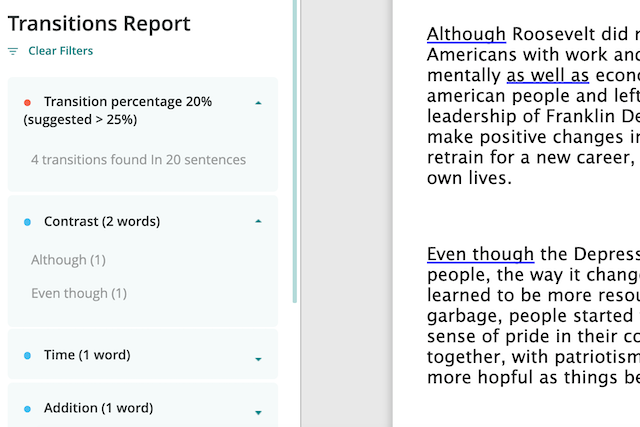
Sign up for a free ProWritingAid account to try it out.
What Are Some Linking Phrases I Can Use in My Essay?
As well as individual words, you can also use short phrases at the beginning of your sentences to transition between ideas. I just did it there—"As well as individual words" shows you how this section of the article is related to the last.
Here are some more phrases like this:
As shown in the example,
As a result of this,
After the meeting,
While this may be true,
Though researchers suggest X,
Before the war began,
Until we answer this question,
Since we cannot assume this to be true,
While some may claim Y,
Because we know that Z is true,
These short phrases are called dependent clauses. See how they all end with a comma? That's because they need you to add more information to make them into complete sentences.
Here are some examples:
- While some may claim that chocolate is bad for you, data from a recent study suggests that it may have untapped health benefits.
- Since we cannot assume that test conditions were consistent, it is impossible to reach a solid conclusion via this experiment.
- As a result of this, critics disagree as to the symbolism of the yellow car in The Great Gatsby.
The bolded text in each example could stand on its own as a complete sentence. However, if we take away the first part of each sentence, we lose our connection to the other ideas in the essay.
These phrases are called dependent clauses: they depend on you adding another statement to the sentence to complete them. When you use a sentence starter phrase like the ones above in your writing, you signal that the new idea you have introduced completes (or disrupts) the idea before it.
Note: While some very short dependent clauses don’t need a comma, most do. Since it is not wrong to use one on even short ones (depending on the style guide being used), it is a good idea to include one every time.
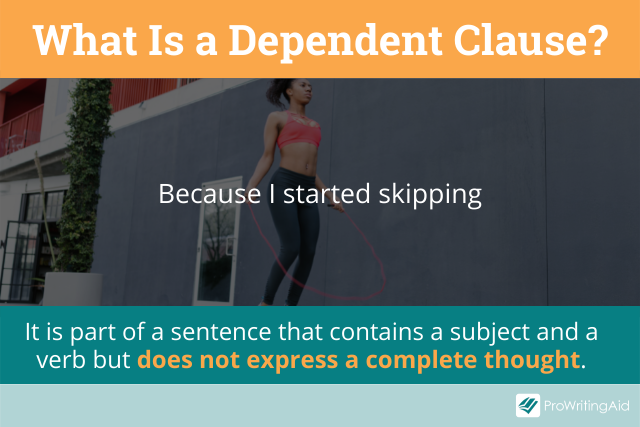
Can I Repeat a Sentence Starter?
Along with missing transitions and repeating sentence structure, another thing that stops sentences from being great is too much repetition. Keep your sentences sharp and poignant by mixing up word choices to start your sentences.
You might start your sentence with a great word, but then you use that same word 17 sentences in a row. After the first couple, your sentences don’t sound as great. So, whether it is varying the transitional phrases you use or just mixing up the sentence openers in general, putting in some variety will only improve your sentences.
ProWritingAid lets you know if you’ve used the same word repeatedly at the start of your sentences so you can change it.
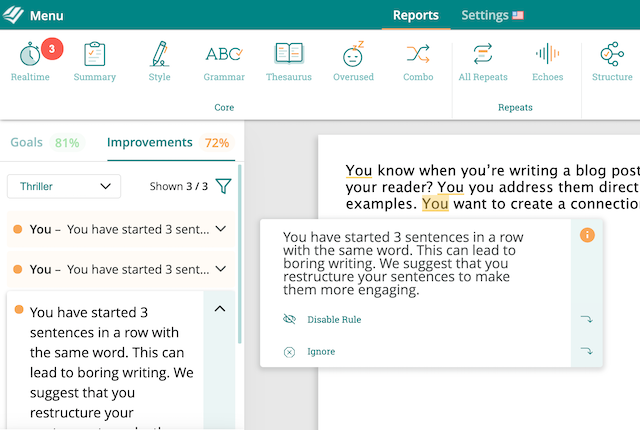
The Repeats Report also shows you all of the repeats in your document. If you've used a sentence starter and then repeated it a couple of paragraphs down, the report will highlight it for you.
Try the Repeats Report with a free ProWritingAid account.
How Can I Rephrase "In Conclusion"?
Now that you have your introduction sentences and body sentences taken care of, let’s talk a little about conclusion sentences. While you will still use transitions and clauses as in the body, there are some special considerations here.
Your conclusion is what people will remember most after they finish reading your paper. So, you want to make it stand out. Don’t just repeat yourself; tell them what they should do with what you just told them!
Use the tips from above, but also remember the following:
Be unique. Not only should you vary the words you use to start different sentences, but you should also think outside of the box. If you use the same conclusion sentence starter everyone else is using, your ideas will blend in too.
Be natural. Some of the best writing out there is writing that sounds natural. This goes for academic writing, too. While you won’t use phrases like "at the end of the day" in essay writing, stilted phrases like "in conclusion" can disrupt the flow you’ve created earlier on.
Here are some alternatives to "in conclusion" you could use in an essay:
- To review, ... (best for scientific papers where you need to restate your key points before making your final statement)
- As has been shown, ...
- In the final analysis, ...
- Taking everything into account, ...
- On the whole, ...
- Generally speaking, ...
If you’re looking for more ways to rephrase "in conclusion," take a look at our complete list of synonyms you can use.

There may not be a set word or words that you can use to make your sentences perfect. However, when you start using these tips, you’ll start to see noticeable improvement in your writing.
If you’ve ever heard people talk about pacing and flow in academic writing, and you have no idea what they mean or how to improve yours, then this is your answer. These tips will help your writing sound more natural, which is how you help your ideas flow.


